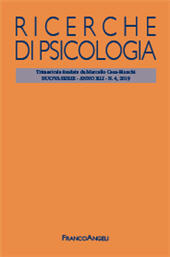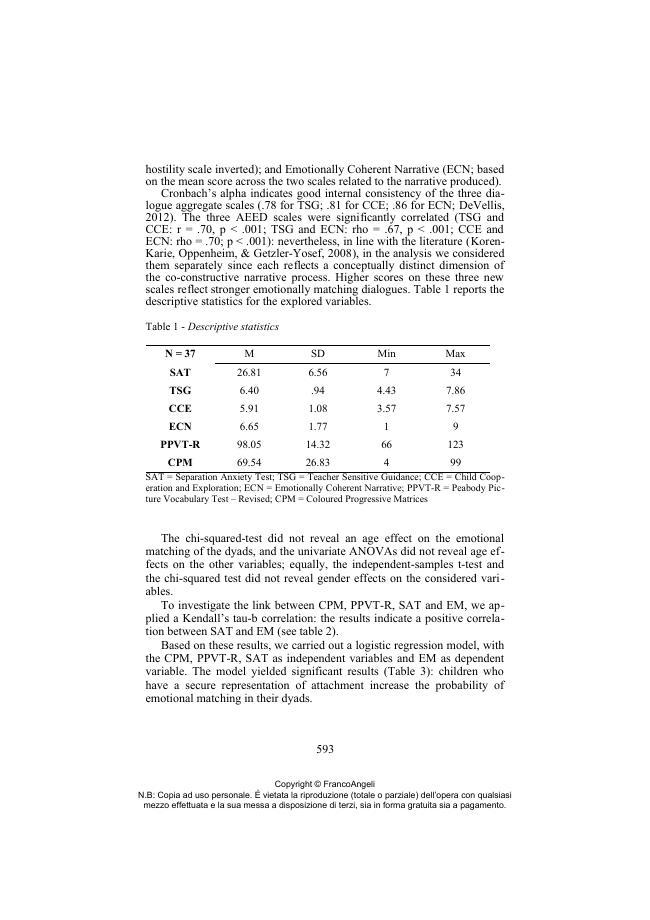2019 - Franco Angeli
Article
Digital Version
Download | Copy/paste | Printing
Teacher-child emotional matching : the role of attachment representation
587-598 p.
- This study examines the role of children's representation of attachment relationships in emotional matching as shown in teacher-child dyads engaged in Autobiographical Emotional Events Dialogue (AEED; Oppenheim, 2007). This task involves the dyad in the co-construction of narratives related to significant emotional episodes lived by the child and evaluates the participation of both partners during this process. Participants were thirty-seven children from five to seven years of age with their three teachers: the dyads completed the AEED and the children were tested with the Separation Anxiety Test - School Version, the Peabody Picture Vocabulary Test - Revised, and the Coloured Progressive Matricies. The results evidenced a link between the quality of teacher-child attach ment from the child's point of view and the emotional matching: children who have a secure representation of attachment significantly increase the probability that the dyad will be emotionally matched. [Publisher's text].
- Questo studio esamina il ruolo della rappresentazione della relazione di attaccamento da parte del bambino nella sintonizzazione emotiva con l'insegnante, in diadi impegnate nell'Autobiographical Emotional Events Dialogue (AEED). Tale compito coinvolge le diadi nella co-costruzione di narrazioni riguardanti episodi emotivamente significativi accaduti al bambino e valuta la partecipazione di entrambi i partner durante questo processo. Hanno partecipato alla ricerca trentasette bambini dai cinque ai sette anni con tre delle loro insegnanti: le diadi hanno completato l'AEED e i bambini sono stati testati con il Separation Anxiety Test - versione scuola, il Peabody Picture Vocabulary Test - Revised e le Coloured Progressive Matricies. I risultati evidenziano un legame tra la qualita della relazione di attaccamento insegnante-allievo dal punto di vista di quest'ultimo e la sintonizzazione emotiva: avere, da parte del bambino, una rappresentazione di attaccamento di tipo sicuro aumenta la probabilità che le diadi s
- iano emotivamente sintonizzate. [Publisher's text].
Is part of
Ricerche di psicologia : 4, 2019-
Information
ISSN: 1972-5620
KEYWORDS
- Relazione insegnante-allievo, sintonizzazione emotiva, attaccamento, dialogo su eventi emotivi
- Teacher-child relationship, emotional matching, attachment, emotional events dialogue
-
In this issue
- L'efficacia dei pasti in famiglia nel contrastare i comportamenti a rischio in adolescenza : una rassegna sistematica della letteratura
- Teacher-child emotional matching : the role of attachment representation
- Stili di memoria e strategie di studio : come le nuove tecnologie cambiano l'apprendimento?
- Introduzione
- Aspetti psicologici del turismo esperienziale
- Psicologia del turismo : dal comitato scientifico interdisciplinare all'A.R.I.P.T. Fo.R.P. : verso nuove professioni manageriali?
- Un approccio psicologico al turismo : i fondamenti teorici avviati dal Maestro
- Il laboratorio incontri generazionali e le ricerche/sperimentazioni di turismo intergenerazionale in alternanza scuola-lavoro
- Turismo, invecchiamento, salute e benessere : riflessioni dai contributi del professor Marcello Cesa-Bianchi
- Fruizione dei beni culturali ed ambientali : intergenerazionalità-interdisciplinarietà
- Turismo rurale : il contributo della psicologia al turismo sostenibile
- Gli itinerari della formazione per le professioni turistiche
- Norme per gli autori



